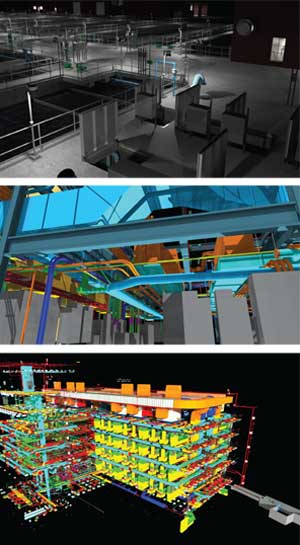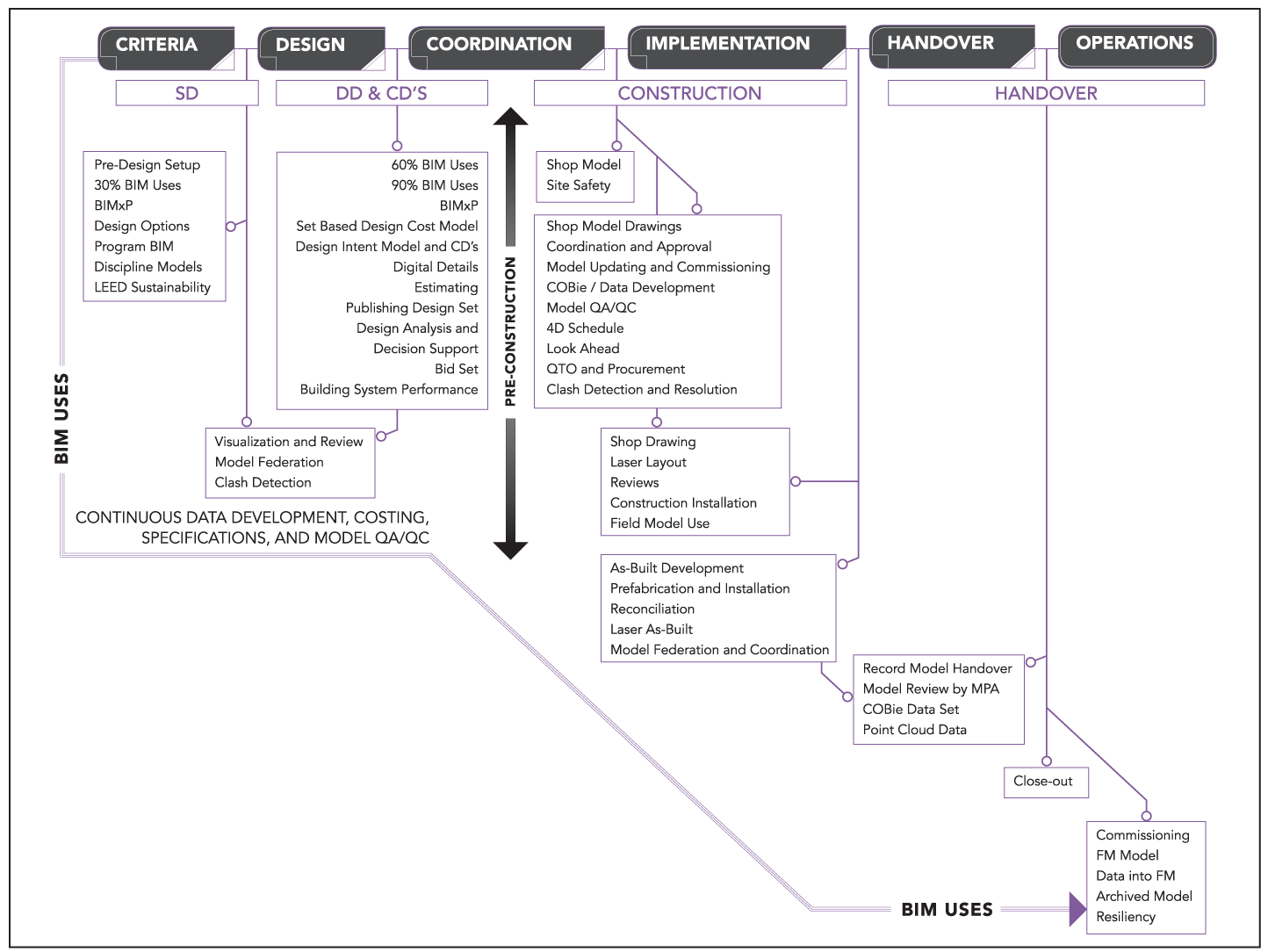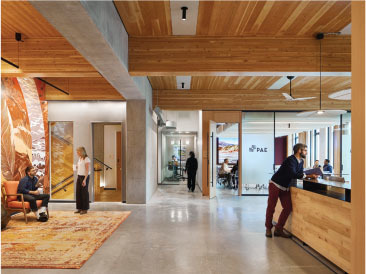January/February 2019
Communities: Private Practice
BIM Beyond Design
BY JACK RAY AND ANGELA R. NEWLAND, P.E., F.NSPE
 Building information modeling (BIM) has been in use for many years, and has evolved into a technology that is being increasingly embraced by engineers in the design of major building projects all over the world. This two-part series highlights efforts underway by the Transportation Research Board’s Airport Cooperative Research Program (ACRP) to provide guidance on how to implement an effective facility life cycle BIM program, and highlights which entities have been successful in using BIM beyond design. This article will describe BIM, the scope of the ACRP BIM study, and notable examples of how BIM is being successfully implemented beyond design. Part 2 will describe the ACRP BIM Beyond Design Guidebook, which outlines how to implement a successful BIM program in a life cycle asset management context.
Building information modeling (BIM) has been in use for many years, and has evolved into a technology that is being increasingly embraced by engineers in the design of major building projects all over the world. This two-part series highlights efforts underway by the Transportation Research Board’s Airport Cooperative Research Program (ACRP) to provide guidance on how to implement an effective facility life cycle BIM program, and highlights which entities have been successful in using BIM beyond design. This article will describe BIM, the scope of the ACRP BIM study, and notable examples of how BIM is being successfully implemented beyond design. Part 2 will describe the ACRP BIM Beyond Design Guidebook, which outlines how to implement a successful BIM program in a life cycle asset management context.
What is BIM?
The National Institute of Building Sciences defines BIM as a “digital representation of physical and functional characteristics of a facility” that is a “shared knowledge resource” that provides a “reliable basis for decisions during its life cycle.” The General Services Administration, which manages all federal public buildings, defines BIM as a “data rich, object-based, intelligent and parametric digital representation of the facility.”

PAST BIM PROJECTS CARRIED OUT BY CCI ENGINEERING SERVICES
BIM documents a facility in three dimensions rather than as two-dimensional plans. BIM enables objects to be placed into a 3D model of a facility to document its geospatial location (coordinates), its placement in the context of other surrounding equipment, and how it is connected as a system. By providing a 3D real-world view of as-built documentation, facility operators can find the data they require more quickly and with fewer errors.
BIM supports a collaborative environment for documenting, analyzing, and sharing facility information across an entire organization. BIM not only reduces facility/asset development costs, but it also improves asset performance and operational readiness. Without BIM, assets are only entries in a database. With BIM, the operation of these assets can be simulated to augment airport planning, maintenance, and operations.
“BIM Beyond Design” Project
The Transportation Research Board’s Airport Cooperative Research Program initiated a project in 2017 to create a guidebook that would help airports implement BIM programs in a life cycle management manner. ACRP recognized that the cost-benefit of using BIM for the design of major facilities was generally understood, but airports were challenged in understanding how to use the models after receiving them from the construction contractors at the completion of major capital projects. The objective of the research was to develop guidance for evaluating the business case for a life cycle BIM program, and to help airport owners understand how to use BIM after construction to enhance life cycle asset management. Life cycle BIM is about developing an ongoing process of asset creation, maintenance, and renewal. As such, BIM affects not only an airport’s facility information infrastructure, but also the way various airport stakeholder groups interact, communicate, and collaborate. Life cycle BIM requires not only technology changes, but cultural changes as well.
The ACRP “BIM Beyond Design” Guidebook, scheduled for publication in spring 2019, will address the following issues:
- Developing the business case and conducting a needs assessment;
- Setting the expected return on investment that may be achievable for BIM beyond design;
- Scaling implementation of BIM;
- Defining the stakeholders and their roles;
- Developing a BIM strategy;
- Outlining the BIM process;
- Integrating BIM into existing systems (i.e., technology architecture) and daily business processes;
- Determining the required data elements;
- Preparing and developing staff for future BIM implementation;
- Defining the progress metrics for implementation;
- Determining BIM governance; and
- Defining the legal and liability issues that exist.
Note that this guidance, while focused on the primary audience of a US airport, applies to any type of owner charged with managing significant facilities, as well as the consultants who assist owners in this effort.
Successful Applications
The research phase of the ACRP Guidebook identified many examples of entities across the world that are progressive users of BIM. Here are some successful applications of various components of BIM programs.
The United Kingdom
The United Kingdom is currently the most progressive country in the world in establishing nationwide BIM standards and goals. The UK has developed some initial standards to support BIM in operations as well as construction. The UK mandated a minimum BIM level of use for all centrally procured public projects by 2016, with the long- term goal of achieving a 20% construction cost reduction from pre-mandate construction costs.
Denver International Airport
Denver International Airport (DEN) has standardized BIM for all new capital development projects. The airport’s goal is to use BIM throughout the asset life cycle, from planning, design, construction, and operations and maintenance. The $544 million Hotel and Transit Center project (completed in 2017) was the first major project managed under the new BIM standards. In addition, DEN has generated a BIM architectural-level model for 95% of the airport terminal. All future projects will have BIM requirements, which will incrementally add BIM detail to the model.
Massachusetts Port Authority
Massport owns and operates Boston Logan International Airport. The Massport BIM Vision states: “Massport will utilize BIM and related technologies to empower its staff and service providers to design and build outstanding structures, and then manage and sustain these facilities to Massport’s mission. As stewards of these digital assets, Massport will maintain BIM, GIS, and facility maintenance asset data to support strategic planning, sound decisions, sustainability, environmental responsiveness, and improved processes to add value to managing the building lifecycle, and to aid Massport in better reinvestment of available funds based upon organizational missions and operational requirements.”
Massport’s BIM process is built upon industry BIM standards. Their BIM “Life Cycle Process Map” provides a clear flow chart of how BIM will be used in a life cycle asset management manner.
Ohio State University
OSU’s “Buckeye BIM initiative” began in 2011, with a goal of developing BIM for 36 million square feet of space within the 561 buildings across all campuses in Ohio. This effort is likely the single largest BIM effort aimed at creating BIM for existing infrastructure developed for facility management purposes. More than 85% of the project is complete. Also, all new buildings and major facility renovation projects have BIM deliverable requirements that conform to the OSU Building Design Standards.
North Royal Adelaide Hospital
The North Royal Adelaide Hospital (nRAH) is the largest BIM project completed in Australia, at a total cost of $1.85 billion. It opened in September 2017. The hospital is 260,000 sq. ft. and provides 800 patient beds.
A “single point of truth” nRAH platform was developed to provide a collaboration tool that links the 3D model with their quality assurance and document management systems to provide a common facility data platform that can be accessed in real-time by all team members. This platform can also be accessed in the field using tablets. The project developed facility management models to support operations and maintenance functions after project delivery.
Next Steps
The use of BIM beyond design is rapidly expanding and constantly evolving. There are many facets to the implementation of successful BIM programs for life cycle facility management. Part 2 of this article series will elaborate on those facets that will be more completely described in the TRB ACRP “BIM Beyond Design” Guidebook, scheduled to be published in the spring of 2019.
Read part two of this article in the March/April issue.
Jack Ray is vice president and COO of CCI Engineering Services and Angela R. Newland, P.E., F.NSPE, is senior project engineer at CCI.
Also contributing to this article was Luciana Burdi, Ph.D., Intl. Assoc. AIA, deputy director for capital programs and environmental affairs at Massport.

MASSACHUSETTS PORT AUTHORITY LIFE CYCLE ROAD MAP


 Volunteering at NSPE is a great opportunity to grow your professional network and connect with other leaders in the field.
Volunteering at NSPE is a great opportunity to grow your professional network and connect with other leaders in the field. The National Society of Professional Engineers (NSPE) encourages you to explore the resources to cast your vote on election day:
The National Society of Professional Engineers (NSPE) encourages you to explore the resources to cast your vote on election day:






